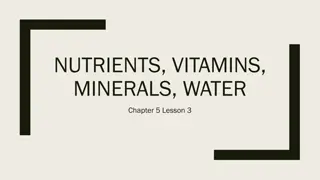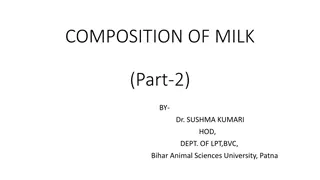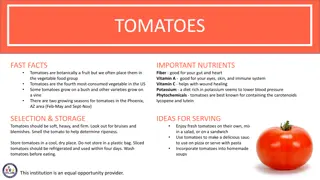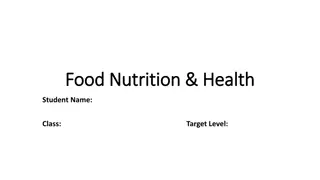Understanding Vitamins: Essential Nutrients for Health
Vitamins are vital organic compounds essential for various body functions, such as regulation, maintenance, growth, and protection. They are classified as fat-soluble (A, D, E, K) and water-soluble (B-complex, C) based on their solubility. Learn about the properties, functions, and sources of vitamins, including Vitamin A, and the importance of maintaining adequate levels for overall well-being.
Download Presentation

Please find below an Image/Link to download the presentation.
The content on the website is provided AS IS for your information and personal use only. It may not be sold, licensed, or shared on other websites without obtaining consent from the author. Download presentation by click this link. If you encounter any issues during the download, it is possible that the publisher has removed the file from their server.
E N D
Presentation Transcript
VITAMINS The term vitamin was coined from the words vital amine as early scientists (1912 by Casmir Funk a polish Biochemist))felt these chemicals which are vital for life wereamines. Vitamins is the term used for a group of potent organic compounds which occur in minute quantities in food and which are essential for some specific body functionssuch as regulation, maintenance, growthand protection. Many of them cannot be synthesized, at least in adequate amounts by the body and must beobtained from thediet. Characteristics: It is vital organic dietary subs which is not CHO, pro, fat or mineral, it is required in small qty to perform a particular function or to prevent def disease, they cannot be synthesized by the body through food though thereareexceptions, Classification Vitaminsaregrouped according to theirsolubility in either fatorwater. Fat soluble vitamins: The fat soluble vitamins are vitamins A,D,E and K. They require fat fortheirabsorptionand can be stored in the body. Water soluble vitamins are B-complex vitamins and vitamin C. They are easily absorbed and theexcess consumed is excreted in the urine. and must be supplied
Properties of Vitamins Fat soluble vitamins: They are soluble in fat and fat solvents such as ether, acetone Intake in excess of daily need is stored in the body( liver and adipose tissue). Not excreted Deficiency symptoms slow to develop if their intake is poor but body stores areample. They are not absolutely needed in diet everyday. They have precursors They contain only the elements: carbon, hydrogen and oxygen They aredestroyed by rancidity Consumed in excess can cause toxicity Water soluble vitamins They are soluble in water They areexcreted in urine There is minimal storageof dietaryexcesses Deficiency symptoms often develop rapidly They must be supplied in the diet everyday They do not have precursors
They contain the elements: carbon, hydrogen, oxygen and nitrogen and in some cases, some contain cobalt and sulphur. Definition of terms Provitamins (precursors): This is any ingested substance which can be converted to vitamins within an organism that is, compounds which are inactive but go form thevitamins. Avitaminosis(hypovitaminosis): This is a deficiency state of a particular vitamin that is, a particular vitamin is lacking to the extent that it will provide deficiency symptoms. Hypervitaminosis: This refers to excess of a particularvitamin. Vitamin supplements: They are concentrated forms of vitamins, which may be in form of tablets, capsules ordrops. General Functions of Vitamins They serve as constituents of enzyme and enzyme systems They regulate the building of major body structures They facilitate the use of energy nutrients.
They do not provide energy but enable the body to use energy from fat, carbohydrates and proteins. Vitamin A Vitamin A is the generic name given to a group of compounds having vitamin A activity These compounds are retinol, retinal and retionic acid Theyare found only in the fatty phases of foods of animal origin. Plant foods contain yellow, orange and /or red coloured pigments called carotene which give colour to vegetables and fruits. Carotene pigments are converted to vitamin A in the body that is, carotene is a precursorof vitamin A. Carotene is synthesized by plants and is the ultimate source of all vitamin A. Pure vitamin A is a pale yellow crystalline compound occurring naturally in theanimal kingdom. It is relatively stable to heat, acids and alkalis. It is easily oxidised and rapidlydestroyed by UV rays.
Functions of Vitamin A It maintains normal vision in dim light It helps in synthesis and maintenance of healthy epithelium- outermost lining of skin and innermost lining of mucous membraneof respiratory, gastrointestinal tract. Vitamin A is required for normal bone and tooth development and propergrowth. It helps the body to fight against infections by keeping mucous membranes in a healthy condition which act as a barrier to infection. Deficiency of vitamin A Night blindness: An individual is unable to see well in dim light Xeropthalmia: Inflammation of cornea Keratomalacia: Softening of the cornea blindness results The epithelium becomes dry, scaly and rough. Goose pimples are seen on upper forearms and thighs. Growth failureand stunted bones are seen in children and permanent
Signs of hypervitaminosis A may include nausea, vomiting, abdominal pain, loss of hair, joint pain Sources: Animal foods such as whole milk and milk products, egg yolk, oily fish, fish-liver oils, organ meat, butter. Sources of carotene include all yellow, orange and red fruits and vegetables such as carrot, pumpkin, mango, papaya and all green leafy vegetables such as spinach, amaranth. Requirements 0-6 months 7-12months 1-3yrs 4-8yrs Males 9-13yrs 14-18yrs 19-30yrs 31-50 51-70 70 yrs retinol/Day 400 g 500 g 300 g 400 g 600 g 900 g 900 g 900 g 900 g 900 g
Females 9-13yrs 14-18yrs 19-30yrs 31-50 51-70 70 yrs 600 g 700 g 700 g 700 g 700 g 700 g
Vitamin D The 2 important forms are vitamin D2 (activated ergosterol or calciferol) and vitamin D3(activated 7-dehydrocholesterol or cholecalciferol). Vitamin D3 is produced when 7-dehydrocholesterol in the skin is exposed to the UV rays in the sun. Vitamin D is heat stable and not easily oxidised, hence it is not harmed by storage, food processing orcooking. Functions of vitamin D Absorption of calcium and phosphorus from the small intestine requires the presence of vitamin D thereby raising their concentration in the blood for normal bone and tooth mineralisation. Regulation of calcium and phosphorus levels in blood.
Sources of vitamin D: Sunlight is the main source of vitamin D. The precursor in skin is converted toactivevitamin D3. It is also found in fish liver oils, fortified milk and margarine, egg yolk, butter. Hypervitaminosis D: Large doses of vitamin D can be toxic. Excessive use of fortified foods lead to loss of appetite, vomitting, diarrhoea, growth failure tissues(deposition of calcium and phosphorus)and kidney stones. Deficiency: Vitamin D deficiency leads to lowered absorption of calcium and phosphorus and reduced bone mineralisation. Bones cannot withstand theweight and bend into deformities Rickets is seen in infants and children. Symptoms of rickets include bowed legs or knocked knees, poor muscle development. Osteomalacia (softening of bones)or adult rickets is more common in women who consume a diet deficient in calcium and phosphorus and vitamin D and have had several pregnancies. and calcification of soft
Requirements: 0 month 51yrs 51 70 yrs 70 years Pregnant and lactating women 5.0 g (200 IU) 10.0 g (400 IU) 15.0 g (600 IU) 5.0 g (200 IU)
Vitamin E (Tocopherol) The term vitamin E is applied to a group of chemical compounds collectively termed tocopherols. The most active of them is -tocopherol. However, about eight different tocopherols and tocotrienols with vitamin E activity have been identified Tocopherols consist of alpha, components. Vitamin E is stable to heatand acids. It is rapidlyoxidised Functions of vitamin E It is the most potent natural antioxidant found in food aided by vitamin C and selenium. It prevents oxidation of vitamin A in the intestine It protects normal cell membranes breakdown. It prevents haemolysis of red blood cells It prevents the oxidation of polyunsaturated fattyacids beta, gamma and delta by preventing their
Sources: Vitamin E is widely distributed in foods, particularly vegetable oils/plant oils (e.g. cotton seed, canola, safflower, and sunflower oils),wheat germ, whole grains, legumes, nuts and dark green leafy vegetables.Animal fats and dairy products contain littlevitamin E. Deficiency: In severe deficiency, although uncommon, increased haemolysis of red blood cells is seen in premature infants. Requirements : Vitamin E requirement increases if the amount of polyunsaturated fattyacids in the diet increases. Vitamin K Vitamin K is essential in the diet because it is needed for synthesis of prothrombin and other blood clotting factors. It exists as vitamin K1, called phylloquinoneis found in plants especially green leafyvegetablesand in animal tissues Vitamin K2, called menaquinone, is snythesized by bacteria in the intestinal tractand K3(syntheticvitamin K) called menadione It is destroyed by light and alkalis. Functions of vitamin K : It is required for the formation of pro- thrombin and several proteins involved in blood clotting.
Sources: Bacterial synthesis in the intestinal tract supplies at least half of the daily needs. Green leafy vegetables, cabbage and pork liver are excellent sources. Cheese, egg yolk and tomato also supplyvitamin K. Requirements: The adequate intake of vitamin K for adults is 60-80 g Deficiency: A deficiency of vitamin K is uncommon in adults. New born infants have a sterile intestinal tract, hence they are given a single dose of vitamin K to prevent haemorrhagic disease. A deficiency interferes with formation of prothrombinogen and thus, reduces clotting tendency of blood.
Water soluble vitamins VITAMIN B COMPLEX Vitamin B complex include Thiamine, Riboflavin, Niacin, B6, Folate, B12, Pantothenic acid, and Biotin. Thiamine (Vitamin B1) Thiamine is a co-enzyme is named B1. It is partially destroyed by heatand alkalis, and is lost in cooking water It is essential for carbohydrates and some amino acids metabolism It is also essential to nerve muscle action It is absorbed in the small intestine It is found in many foods in small quantities.
Riboflavin It is destroyed by light and irradiation. It is unstable in alkalis It is essential forcarbohydrate, fat and protein metabolism It is necessary for tissue maintenance, especially the skin around the mouth, and for healthyeyes. It is absorbed in the small intestine Sources It is widely distributed in animal and plant foods in small amount. Some of its rich sources are milk, meat, poultry, fish and enriched bread and cereals. Some green vegetables such as broccoli, spinach and asparagus are good sources. Average adult female require 1.1mg/day, while average adult male require 1.3mg/day Requirement increases with increased energy expenditure.
A deficiency of riboflavin can result in: 1. Cheilosis, a condition characterized by sores on the lips and crack at thecorner of the mouth. 2. Glossitis or inflammation of the tongue 3. Dermatitis, eye strain in form of itching, burning, and eye fatigue. NIACIN (B3) Niacin is the generic name for nicotinic acid and nicotinamide. It is fairly stable in foods, and can withstand reasonable amount of heat. The acid is not destroyed during food storage. It serves as coenzyme in energy metabolism and is essential to every body cell. It is essential for prevention of pellagra a disease characterized by sores in the skin, and by diarrhoea, anxiety, confusion, irritability, poor memory, dizziness and death if untreated.
Sources The best sources of niacin are meat, poultry, and fish. Peanuts and other legumes are good sources. Enriched breads and cereals. Vegetables and fruits contain little niacin. Requirement Adultwomen -14mg/day, adult men 16mg/day Deficiency Niacin deficiency can occur if there is deficiency of riboflavin. Symptoms include weakness, anorexia, indigestion, anxiety, and irritability. In extremecases, pellagra mayoccur
VITAMIN B6 Vitamin B6comprises of three related forms namely: pyridoxine, pyridoxal and pyridoxamin. It is stable to heat but sensitive to lightand alkalis. Vitamin B6is important in protein metabolism and absorption, and itaids in the rleaseof glucose from glycogen. Vitamin B6help in converting excess amino acid to those in which the body is temporarilydeficient. It serves as catalyst in the conversion of tryptophan to niacin and is helpful in the formation of other substances from amino acids such as serotonin and dopamine. Sources Poultry, fish, liver, kidney, potatoes, bananas and spinach. Wholegrain, esp. oats and wheat are good sources of vitamin B6.
Requirements The need for vitamin B6 increases as the protein intake increases. Adult female 1.3 1.5mg/day, adult male 1.3 1.7mg/day Deficiency Vitamin B6deficiency can result in irritability, depression, and dermatitis. Its deficiency in infants can cause various neurological symptoms and abdominal problems.
Cyanocobalamin(vitamin B12) It is found only in foods of animal origin. It helps folic acid in the synthesis and maturation of red blood cells. It is essential for formation of myelin sheath around nerve fibres. Sources Liver, kidney, milk, eggs and cheese Requirement Small amount of animal protein in the diet take care of vitamin B12 requirement. Deficiency Vitamin B12 deficiency results in either megaloblastic anaemia or pernicious anaemia. Symptoms of vitamin B12 deficiency include pale eyes and skin, tongue is raw and red, mouth ulcers.
Pantothenic acid and biotin They are both co-enzymes required for release of energy from carbohydrates, fats and proteins. Both vitamins are widely present in foods and deficiency is rare. Folic acid Folic acid helps in the formation of red blood corpuscles and helps in preventing anaemia In order to perform its functions, folic acid needs to be converted into its active form. Vitamin C is needed for this conversion. Sources Liver, kidney, green leafyvegetables, whole pulses, yeast Deficiency Deficiency results in megaloblastic anaemia
Vitamin C Vitamin C helps in synthesis of collagen which is the intercellular cementing substance that keeps cells in bone and muscle tissue together It helps in healing of wounds and fractures It increases resistance to infections and fevers It is an antioxidant. Sources Fresh citrus fruits, other fruits and vegetables Deficiency Scurvy (swelling, infection and bleeding of gums); painful joints, poorwound healing because collagen is not synthesized.























